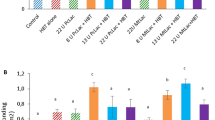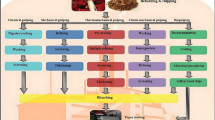Abstract
White rot fungi were optimized to cultivate highly active laccase. The characteristics of laccase incubated by continuous culture were compared with those of direct culture. The enzyme activity of laccase incubated by continuous culture technology reached a higher value on the fifth day of the growth. The optimization incubation time of high activity laccase was the eleventh day. A large amount of highly active laccase can be obtained in a relatively short time by continuous culture to replace traditional laccase. After laccase treatment, the lignin composition of wood fibers were oxidation-catalyzed by laccase. The number of chemical-bonding points between the wood fibers was increased. The wood fibers treated by laccase were fabricated into boards and their mechanical properties improved with the laccase-incubation times. Compared with the fiberboards made from fibers that were pre-treated by laccase of incubation 5 days, the static bending strength of those that were pre-treated by laccase of incubation 11 days was increased by 18.95%, the elastic modulus was increased by 35.49%, and the internal bond strength was increased by 44.11%.










Similar content being viewed by others
References
Álvarez C, Rojano B, Almaza O, Rojas OJ, Gañán P (2010) Self-bonding boards from plantain fiber bundles after enzymatic treatment: adhesion improvement of lignocellulosic products by enzymatic pre-treatment. J Polym Environ 19(1):182–188
Baldrian P (2006) Fungal laccases—occurrence and properties. FEMS Microbiol Rev 30(2):215–242
Barsberg S, Nielsen KA (2003) Oxidative quenching of spruce thermomechanical pulp fiber autofluorescence monitored in real time by confocal laser scanning microscopy-implications for lignin autofluorescence. Biomacromolecules 4(1):64–69
Baskaran M, Hashim R, Said N, Raffi SM, Balakrishnan K, Sudesh K, Sulaiman O, Arai T, Kosugi A, Mori Y (2012) Properties of binderless particleboard from oil palm trunk with addition of polyhydroxyalkanoates. Compos B Eng 43(3):1109–1116
Dales R, Liu L, Wheeler AJ, Gilbert NL (2008) Public health: quality of indoor residential air and health. Can Med Assoc J 179(2):147–152
Elegir G, Bussini D, Antonsson S, Lindström ME, Zoia L (2007) Laccase-initiated cross-linking of lignocellulose fibres using a ultra-filtered lignin isolated from kraft black liquor. Appl Microbiol Biotechnol 77(4):809–817
Felby C, Thygesen LG, Sanadi A, Barsberg S (2004) Native lignin for bonding of fiber boards-evaluation of bonding mechanisms in boards made from laccase-treated fibers of beech (Fagus sylvatica). Ind Crops Prod 20(2):181–189
Geng X, Zhang SY, Deng J (2006) Alkaline treatment of black spruce bark for the manufacture of binderless fiberboard. J Wood Chem Technol 26(4):313–324
Gold MH, Alic M (1993) Molecular biology of the lignin-degrading basidiomycete phanerochaete chrysosporium. Microbiol Rev 57(3):605–622
Ikeda R, Uyama H, Kobayash S (1996) Novel synthetic pathway to a poly(phenylene oxide). laccase-catalyzed oxidative polymerization of syringic acid. Macromolecules 29(8):3053–3054
Kelly TJ, Smith DL, Satol J (1999) Emission rates of formaldehyde from materials and consumer products found in california homes. Environ Sci Technol 33(1):81–88
Lei NS, Zhou RY, Chen T, Liu ZH, Zhong GM, Yu-Sheng LI, Zhi LI, Huang JP (2015) Investigation and analysis of indoor formaldehyde level in newly decorated apartments in Nanning City between 2004 and 2011. Mod Prev Med 42(8):1389–1391
Liu Y, Zhu X (2014) Measurement of formaldehyde and VOCs emissions from wood-based panels with nanomaterial-added melamine-impregnated paper. Constr Build Mater 66(66):132–137
Liu Y, Shen J, Zhu XD (2010) Influence of processing parameters on VOC emission from particleboards. Environ Monit Assess 171(1–4):249–254
Liu Y, Shen J, Zhu XD (2015) Evaluation of mechanical properties and formaldehyde emissions of particleboards with nanomaterial-added melamine-impregnated papers. Eur J Wood Wood Prod 73(4):449–455
Mayer AM, Staples RC (2002) Laccase: new functions for an old enzyme. Phytochemistry 60(42):551–565
Mobarak F, Fahmy Y, Augustin H (1982) Binderless lignocellulose composite from bagasse and mechanism of self-bonding. Holzforschung 36(36):131–136
Muller C, Euring M, Kharazipour A (2009) Enzymatic modification of wood fibres for activating their ability of self bonding. Int J Mater Prod Technol 36(36):189–199
Riquelme-Valdés J, Ramírez E, Contreras D, Freer J, Rodríguez J (2008) Fiberboard manufactured without resin using the fenton reaction. J Chil Chem Soc 53(4):1722–1725
Saadaoui N, Rouilly A, Fares K, Rigal L (2013) Characterization of date palm lignocellulosic by-products and self-bonded composite materials obtained thereof. Mater Des 50:302–308
Salthammer T, Mentese S, Marutzky R (2013) Formaldehyde in the indoor environment. Chem Rev 110(4):2536–2638
Sharma P, Goel R, Capalash N (2007) Bacterial laccases. World J Microbiol Biotechnol 23(6):823–832
Shen KC (1986) Process for manufacturing composite products from lignocellulosic materials. US4627951
Velásquez JA, Ferrando F, Salvadó J (2002) Binderless fiberboard from steam exploded Miscanthussinensis: the effect of a grinding process. HolzalsRoh- und Werkst 60(4):297–302
Widsten P, Kandelbauer A (2008) Adhesion improvement of lignocellulosic products by enzymatic pre-treatment. Biotechnol Adv 26(4):379–384
Wieslander G, Norbäck D, Björnsson E, Janson C, Boman G (1997) Asthma and the indoor environment: the significance of emission of formaldehyde and volatile organic compounds from newly painted surfaces. Int Arch Occup Environ Health 69(2):115–124
Zhang D, Zhang A, Xue L (2015) A review of preparation of binderless fiberboards and its self-bonding mechanism. Wood Sci Technol 49(4):661–679
Zhu X, Liu Y (2014) Characterization and risk assessment of exposure to volatile organic compounds in apartment buildings in Harbin, China. Bull Environ Contam Toxicol 92(1):96–102
Author information
Authors and Affiliations
Corresponding author
Additional information
Project funding: This study was funded by National Natural Science Foundation of China (31170515), Specialized Research Fund for the Doctoral Program of Higher Education of China (20130062110012) and Undergraduate Training Program for Innovation and Entrepreneurship of Northeast Forestry University, China (201410225157).
The online version is available at http://www.springerlink.com
Corresponding editor: Yu Lei.
Rights and permissions
About this article
Cite this article
Zhu, X., Han, S., Liu, Y. et al. Effects of laccase incubated from white rot fungi on the mechanical properties of fiberboard. J. For. Res. 28, 1293–1300 (2017). https://doi.org/10.1007/s11676-017-0398-3
Received:
Accepted:
Published:
Issue Date:
DOI: https://doi.org/10.1007/s11676-017-0398-3




